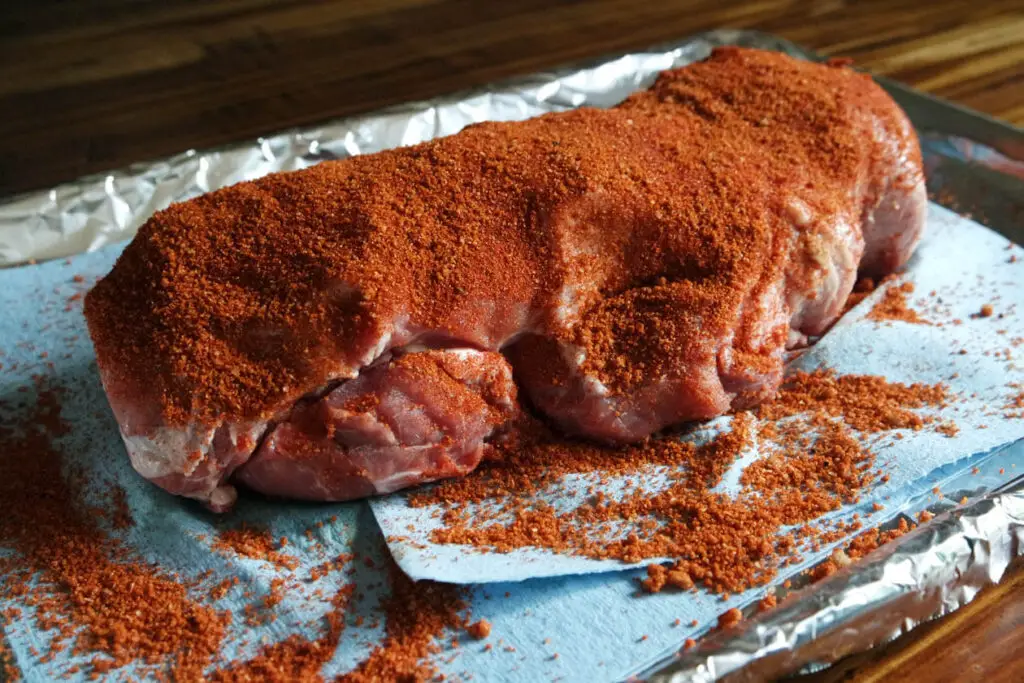What is “Good” BBQ Bark?
Good bark refers to the dark, crunchy crust that forms on the surface of meats when they are smoked. This crust is created through a combination of heat, smoke, and the Maillard reaction, which is a chemical process that occurs between the amino acids and reducing sugars in the meat. The bark is an important part of the flavor and texture of smoked meats and can help to seal in the juices, making the meat more tender and flavorful.
Getting a good bark is important when smoking meats because it adds an extra layer of flavor and texture to the final product. It also helps to seal in the juices, keeping the meat moist and tender. A good bark is a sign that the meat has been properly cooked and smoked, and can greatly enhance the overall taste and experience of eating smoked meats.
How To Get a Good Bark with a Pellet Smoker
So now you know what a good bark is, but how do you get a good bark with a pellet smoker? There are several different factors, which include:
- Temperature
- Airflow
- Rubs & Sauces
- Meat Preparation

#1 Maintain The Right Temperature
Maintaining the correct temperature is essential for good bark formation. When smoking meat, it is important to maintain a temperature that is low enough to allow the smoke to penetrate the meat, but high enough to promote the Maillard reaction and other chemical reactions that are important in the formation of the bark. Generally, the ideal temperature for smoking meat is between 225°F and 250°F.
#2 Good Airflow
Airflow and ventilation play a critical role in maintaining the correct temperature in a pellet smoker. Proper airflow helps to circulate the smoke around the meat, which enhances the flavor and color of the bark. Ventilation is also important, as it helps to regulate the temperature and prevent the smoker from becoming too hot or too cold. To ensure proper airflow and ventilation, it is important to follow the manufacturer’s instructions and make any necessary adjustments as needed.

#3 Use The Right Rub & Sauce
Rubs and sauces can also play a role in bark formation. Rubs, in particular, can help to enhance the flavor of the bark by adding spices and herbs to the surface of the meat. Sauces, on the other hand, can impact the formation of the bark by adding sugar and other ingredients that can affect the Maillard reaction. It is important to be mindful of the ingredients in your rubs and sauces, as they can have a significant impact on the final result. When using rubs and sauces, it is best to apply them sparingly and monitor the formation of the bark closely to ensure that it does not become too dark or burnt.
#4 Properly Prepare Your Meat
The drying process is important in helping to form good bark. Before smoking the meat, it is important to let it sit at room temperature for a period of time to allow the surface of the meat to dry out. This will help to create a surface that is ideal for the formation of the bark. To speed up the drying process, you can pat the meat dry with paper towels or use a fan to circulate air around it.
The Science Behind BBQ Bark
The Maillard Reaction
The Maillard reaction is a chemical process that occurs between the amino acids and reducing sugars in the meat, resulting in the formation of complex flavor and color compounds. This reaction takes place when the surface of the meat is exposed to heat, and it is an important factor in the formation of good bark. The Maillard reaction is what gives the bark its characteristic dark color and rich, caramelized flavor.
Smoke, Heat, & Time
Smoke, heat, and time are the key elements that come together to form good bark. The smoke provides the flavor, while the heat and time allow the Maillard reaction to take place. It is important to maintain a consistent temperature in the smoker, as fluctuations in temperature can affect the formation of the bark. Additionally, smoking the meat for an appropriate amount of time will allow the Maillard reaction to occur, resulting in a well-formed and flavorful bark.
Pellet Smoker Adjustments
There are several adjustments that can be made to a pellet smoker to promote optimal bark formation. Some of the most important include adjusting the temperature, adjusting the airflow and ventilation, and adjusting the placement of the meat in the smoker. When making these adjustments, it is important to monitor the formation of the bark closely and make any necessary changes to ensure that the bark is forming evenly and to your desired level of darkness and crispiness. Additionally, it is important to keep the smoker well-stocked with pellets to ensure that the fire remains consistent and that the temperature remains steady throughout the smoking process.
How To Determine When Bark is Done
To determine when the bark is done, you should monitor the color, texture, and crispiness of the bark. When the bark is dark, crusty, and slightly crisp, it is typically ready. Additionally, you can monitor the internal temperature of the meat to ensure that it has reached the desired level of doneness.
Final Tips
Some final tips and tricks for achieving good bark with a pellet smoker include: using a high-quality rub, using a quality sauce, using the right type of pellets, monitoring the temperature and airflow, and experimenting with different smoking methods and techniques. With these tips and tricks in mind, you should be able to achieve delicious and flavorful bark every time you use your pellet smoker.
In order to achieve good bark with a pellet smoker, you need to understand the science behind bark formation, choose the right pellet smoker, prepare the meat properly, set up the smoker correctly, smoke the meat, and wrap it up properly.
In addition to these steps, it is important to experiment with different rubs and sauces to find the flavors and textures that you enjoy the most. Each rub and sauce will produce a unique flavor profile, so be sure to try out a variety of options to find the ones that work best for you.
Getting a good bark is an essential component of great smoked meats. It provides flavor, texture, and color, and helps to create a delicious and satisfying finished product. So whether you’re a seasoned pro or a beginner, take the time to perfect your bark-making skills and enjoy the delicious and flavorful results.
FAQs
If you’re looking to get more bark on your smoked meats using a pellet smoker, there are a few tips that can help you achieve the desired result:
Use a lower temperature
When smoking meat at a lower temperature, it will take longer to cook, but the result will be a more pronounced bark on the meat.
Use a dry rub
A dry rub applied to the meat before smoking will help create a crust on the surface of the meat, which will result in a thicker bark.
Increase the airflow: Increasing the airflow to your pellet smoker will help create a drier cooking environment, which will result in a more pronounced bark on your meat.
Use a water pan
Adding a water pan to your pellet smoker can help regulate the cooking temperature and prevent the meat from drying out, while still allowing the bark to develop.
By using these tips, you can get more bark on your smoked meats using a pellet smoker, resulting in a delicious and flavorful crust on the surface of the meat
If your pellet smoker is not producing the desired bark on your smoked meats, there could be a few reasons why:
Cooking temperature
Pellet smokers are designed to cook at a lower temperature, and if the temperature is too high, it can cause the meat to cook too quickly and prevent the bark from forming.
Moisture
If the meat is too moist, it can prevent the bark from forming. Be sure to pat the meat dry before seasoning and smoking it.
Lack of dry rub
Applying a dry rub to the meat before smoking it can help create a crust on the surface of the meat, resulting in a thicker bark.
Short cooking time
If the meat is not cooked long enough, it may not develop the desired bark. Be patient and allow enough time for the meat to cook and the bark to form.
Inconsistent temperature
Fluctuations in temperature can also prevent the bark from forming. Be sure to maintain a consistent temperature throughout the cooking process.
By addressing these issues, you can help your pellet smoker produce the desired bark on your smoked meats, resulting in a delicious and flavorful crust on the surface of the meat.
The temperature at which you smoke your meats can have an impact on the quality of the bark. When it comes to creating a flavorful bark on your smoked meats, a lower cooking temperature is generally better. Many pitmasters prefer to smoke their meats at around 225°F because it allows the meat to cook slowly and evenly, which can result in a thicker and more pronounced bark. However, cooking at a slightly higher temperature, such as 250°F, can also produce good results, as it can help the bark to develop more quickly without drying out the meat. Ultimately, the best temperature for smoking your meats depends on your personal preference and the type of meat you are cooking. Experiment with different temperatures and cooking times to find the perfect balance that produces the best bark and flavor for your smoked meats.
Achieving a thick bark on your smoked meat is all about the cooking process and the techniques used. Here are some tips to help you create a thick bark on your smoked meat:
Apply a dry rub: Applying a dry rub to your meat before smoking it can help create a flavorful crust on the surface, which can result in a thicker bark.
Cook at a lower temperature: Cooking at a lower temperature, such as 225°F, allows the meat to cook more slowly, which can help develop a thicker bark.
Use hardwoods for smoking: Hardwoods such as oak, hickory, or mesquite are excellent for creating a thick bark, as they release more smoke and provide a stronger flavor.
Do not wrap the meat: Wrapping the meat during the cooking process can cause it to steam and prevent the bark from forming. If you prefer to wrap the meat, do so after the bark has formed.
Avoid opening the smoker: Opening the smoker frequently can cause fluctuations in temperature and prevent the bark from forming. Keep the smoker closed as much as possible to maintain a consistent temperature.
By following these tips, you can create a thick and flavorful bark on your smoked meat, resulting in a delicious and satisfying dish.








